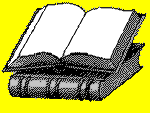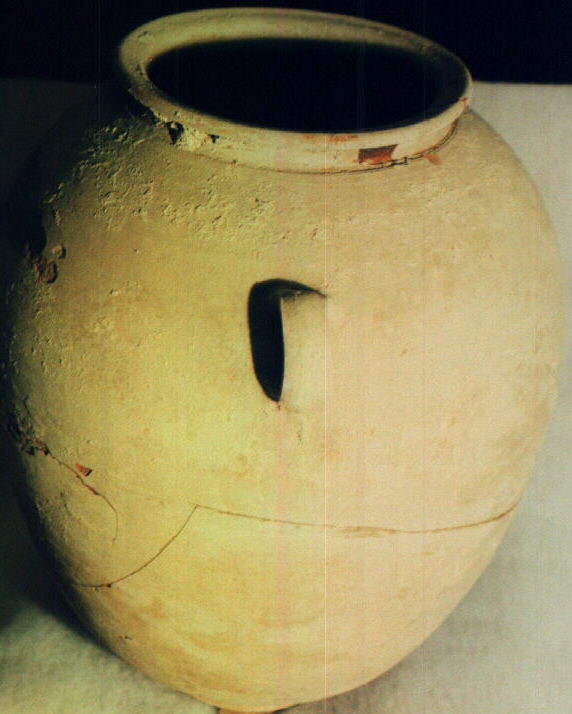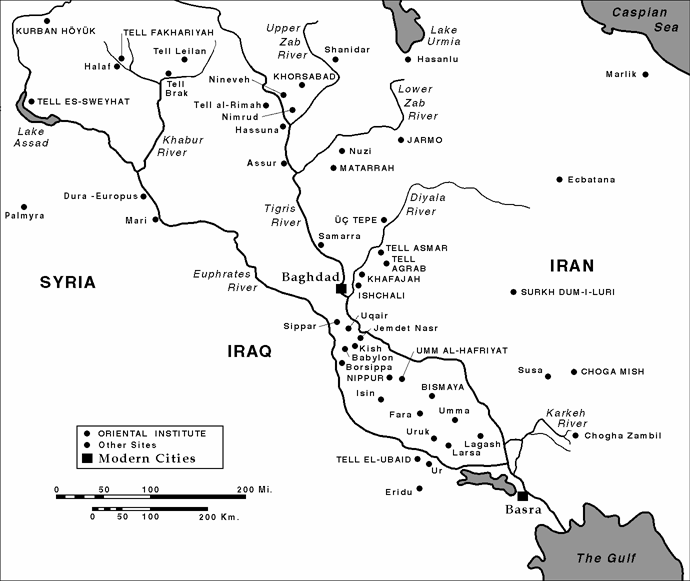
Religious Studies 101 (Honors)--Fall Semester, 2000
Literature and World of the Old Testament

Office: Public Affairs Classroom Building 351 |
Office Hours: 10:00-10:50 M-F; 2-2:50 M |
Phone: 836-5491 or 5516 |
Email: VHM970F@MAIL.SMSU.EDU |
1.Texts Required:

a. V. Matthews & J. Moyer, The Old Testament: Text and Context (Hendrickson, 1997)
b. V. Matthews & D. Benjamin, Old Testament Parallels (2nd edition; Paulist, 1997)
c. H.T. Frank, Hammond Atlas of the Bible Lands
d. Any one of the modern translations of the Bible--preferably the New Revised Standard Version, New English Bible, New American Bible, Jerusalem Bible, New Jewish Publication Society Version, or New International Version. Do not use the King James Version. Although it is a beautiful literary translation, it is hard to understand for most modern students and is outdated. I will use the NRSV in class.
Some useful Web Sites for archaeological, biblical and ancient Near Eastern studies are:
ABZU
K.C. Hanson's Personal Web Page
An on-line concordance featuring several biblical translations can be found at: http://bible.gospelcom.net
I also encourage students to click on the various web links that I have established throughout this syllabus to obtain additional information.
The Old Testament: Text and Context
will be used as a supplement to lectures. Students will benefit by using this preliminary manuscript to increase their understanding of both the biblical material and the lectures. Old Testament Parallels contains translations of ancient Near Eastern texts that will be used in class discussion comparing them with biblical stories and laws. The Hammond Atlas of the Bible Lands contains a set of maps I will be using on transparencies in class and provides a good visual perspective on the lands discussed in the course lectures.2. Course Description: This course is a part of the General Education curriculum in the area of Culture and Society/Humanities. It is an introduction or survey of the literature of the Old Testament/Hebrew Bible. As a way of further illuminating these materials, attention will also be given to the history and religion of Israel as well as the other peoples of the ancient Near East. Its application to the Public Affairs Mission of the University can be found in its efforts to educate students about the past so that they can build upon this heritage in making informed decisions about their own culture and the future direction of society. Student input is welcomed as a partial guide to material covered.
3. Classroom routine: Since this is a course introducing the Biblical materials, the presentation in class will be for beginners. The Biblical text will be carefully followed to determine and explain what the authors are saying. This will involve a lecture/discussion format and occasional use of audio-visual materials. I will be constantly asking questions of students to emphasize points and determine mastery of the material, and ungraded free writing assignments will also be used. I welcome student questions and expect that the number of these questions will increase as the semester progresses.
4. Religious Studies Courses in a State University: The U.S. Supreme Court (Abington v. Schempp) in 1963 encouraged the objective study of religion and the Bible. This is why we teach an introductory course to the Old Testament/Hebrew Bible at SMSU. However, the approach here is different from that taken in a religious group. We will concentrate on what the text originally meant in the light of its ancient Near Eastern setting rather than on what the text means for us today. You do not have to have a faith commitment in this course, nor will you be asked to abandon your faith. My purpose is to increase your knowledge and understanding of the Old Testament/ Hebrew Bible, and to help you think carefully and in new ways about what it originally meant. You will earn a good grade in this class the same way you do in other courses, not by being more religious.
5. Purposes:
a. Provide students with a basic understanding of the OT/HB and of ancient Israel that will serve as the foundation for future study.
b. Provide the student with a basic knowledge of the history of the biblical periods, noting the relationship between Israel and the other nations of the ancient Near East.
c. Provide students with a basic knowledge of the physical environment and geographical features of the ancient Near East.
d. Give students an understanding of the principal beliefs of the OT/HB people about God and humankind.
e. Present to students for their use the tools and approaches that scholars use to study the OT/HB.
f. Prepare students to deal openly and intelligently with the text of the OT/HB, neither minimizing nor over-emphasizing the very real historical and theological difficulties that they will encounter.
g. Demonstrate to students that the study of religions in a state university setting is a natural part of a humanities curriculum and of the university's Public Affairs mission.
h. Help students to take seriously, state accurately, and evaluate thoughtfully positions other than their own.
6. Attendance: Statistical analysis has shown that regular attendance is the key to good grades. It is expected that all students will be present except for emergencies.
7. Class Participation:
A significant portion of your grade
(75 points) is dependent upon class participation. I will assign this grade at the end of
the course. It will be based on attendance, ability to answer questions during regular and
scheduled class discussions, in-class assignments, willingness to ask questions and seek
help (both in and out of class), and general improvement in class discussion over the
course of the semester.
![]()
8. Inclusive Language: In line with the newest style guides, I will be using inclusive language. This means that I will use language that includes women whenever possible. Instead of "man" I will use "human beings." Instead of "he" I will use "he or she," etc. I urge you to follow my lead both orally and in written form.
9. Exams: There will be three exams and a final. They will consist of essays, short identifications, and map questions. These exams will be given approximately at the 4th, 8th, & 12th week of the course. The final will cover both newly discussed material and a comprehensive essay. Before each exam I will provide students with a study guide. Please bring a blue book and a pen on each exam day.
![]()
10. Make-Up Exams: Make-up exams (though usually more difficult than regular tests) will be permitted only for those students with LEGITIMATE explained absences. Students should strive to notify me in advance if they know they will have to be gone on a scheduled exam day.
11. In-Class Reports: Each student will be required to make one in-class report on an assigned topic. These reports will require an oral presentation of approximately 10 minutes each to introduce or clarify an issue or an event. A list of assigned topics appears below.
12. Written Assignment: Each student is required to do the following:
Articles from journals and books are on reserve in the library (both on-line and hard copy). You are to read two of these articles and then write a short (2 pages) summary of each article's contents and a one page personal analysis of (1) the author's style of writing, (2) the degree of difficulty you had in reading it, (3) what you found particularly interesting, (4) ways in which it could be improved or made more understandable, (5) value of visual and explanatory aids, and (6) the ways in which the article has aided your fuller understanding of the Old Testament.
Choose specific items in each article upon which to base your analysis. Include (1) the author, (2) title of the article, (3) title of journal or book, (4) issue number, (5) year, and (6) page numbers for each article summarized. The first of these analyses (worth 25 points each) is due September 15, 2000. The second is due on October 27, 2000. A two point per class day penalty will be imposed on each paper submitted after the date it is due.
![]()
13. Extra Credit: One immediate way of adding five points to your grade is to come see me in my office during the first two weeks of the semester. I will have extra office hours during this period and will look forward to having the opportunity of meeting and speaking with each of you in private about your expectations for the course. As preparation, visit my home page on the web. No other extra credit is offered.
14. Cheating: Cheating and plagiarism, as defined in the SMSU Student Judicial Code will not be tolerated in this course. Anyone caught cheating will be assigned an "F" for the course. I would also direct you to the university statement of community principles.
15. Assessment: Students' command of the materials presented in this course will be assessed through written exams, ungraded "free writing" assignments, journal article critiques, class discussion, in-class oral presentations, and the ability to answer the instructor's questions during class. These methods of assessment will help gauge the effectiveness of presentation by the instructor as well as help demonstrate the usefulness of this course as a part of the General Education curriculum. Students will also be given the opportunity to assess the course as a whole using a standardized, departmental questionnaire.
16. Grading: The final grade will be computed as follows:
Exams I, II, & III- 225 points (75 points each)
Final Exam-- 100
points
Article Analyses-- 50 points
Class Participation-- 100 points
Total possible points- 475
The grading scale for the final grade will be based on the scale: A =
90-100; B = 80-89; C = 70-79;
D = 60-69; F = Below 60
Borderline grades will be determined by such factors as attendance, the final exam, completion of work on time, evidence of hard work and a willingness to seek help, and general contribution to class discussions.
17. Disability Accommodation: Students with disabilities who may require accommodations should contact Jana Long, Coordinator of Disability Support Services (DSS), Plaster Student Union, 4th floor, (417) 836-4192 or TDD (417) 836-6792. Information about DSS can be found at http://www.smsu.edu/disability/ DSS refers some types of accommodation requests to the Learning Diagnostic Clinic (LDC). The LDC also provides diagnostic testing, for which a fee is charged. Information about the LDC can be found at http://www.smsu.edu/contrib/ldc/index.html
18. Office Hours: Students should feel free to consult with me about the course and their work. My office is PACB 351 and I will be there M-F 10:00-10:50. If you can not meet with me during these times, see me after class and I will arrange a mutually convenient time for us to get together. The Economics office phone is 836-5516 and the secretary can make an appointment for me. I can also be contacted by e-mail at: VHM970F@MAIL.SMSU.EDU
TENTATIVE SCHEDULE -- RELIGION 101
Textbooks will be referred to below in abbreviated form (OTC and OTP). Reading should be completed as assigned before class. You are responsible for all reading assignments and you will be questioned about the material they contain in class discussion or asked to do free writing assignments about them. I will use the study questions at the end of each chapter in OTC as part of class discussion and as an aid in writing the exams. Plan to spend at least four to six hours per week in preparation for this class. The academic calendar is available at: http://www.smsu.edu/recreg/accal_2000-2001.html
Section One:
Introduction to the class. Pre-test. Syllabus, assignments, and grading. Discussion of tools for biblical study, as well as cautions regarding ancient texts. OTC, 1-11.
 Qumran Storage Jar
Qumran Storage Jar
Archaeology. Film: "Megiddo" and a discussion of the methods, values and limitations of archaeology for biblical research and field school opportunities. Read OTC, 11-20.
Oral Tradition and Canon. Writing Systems, textual analysis, Dead Sea Scrolls, the history of interpretation, and the development of the canon. Class Discussion: the authorship of the Pentateuch. Read OTC, 20-30 and write answers to questions (OTC, 31).
Physical Environment of the Ancient Near East. Discussion of the major geographical features of the ancient Near East and their influence on cultural development. Read OTC, 33-42. For site maps click here!

Creation and the differences between Polytheism and Monotheism. Read OTC, 43-48; OTP, "The Enuma Elish Stories," 9-18 and "The Hymn to Ptah," 3-5, "Stores of Adapa," 41-45; Gen 1-4.
The Flood Story. Read Gen 6-9; OTC, 49-50; OTP, "Stories of Gilgamesh," 19-30 and "Stories of Atrahasis," 31-40.
The Ancestors: Abraham, Isaac, and Jacob. Read Gen 12, 16-19, 21-34 and OTC, 50-56; OTP, "Nuzi Archives," 46-51.
Joseph, Goshen, and Slavery. Read Gen 37-45; OTC, 56-57; OTP, "Stories of Anubis and Bata," 61-65.
Moses and the Exodus Event. Read Exodus 1-5, 10-14, 19-20, 24, 32-34; OTC, 57-62; OTP, "Annals of Dedumoses," 58-60; "Annals of Sargon I," 85.
EXAM #1: Genesis and Exodus (75 points)
Section Two:
Sinai, Wilderness, Law. Read Ex 21-22; Num 13, 16, 20, 22-24; Dt 21-22, 34; OTC, 62-67; OTP, "Code of Hammurabi," 101-109, and "Stories of Balaam," 124-126.
Joshua and the Conquest. Read Joshua 1-11, 24; OTC, 68-79; OTP, "The El Amarna Letters," 137-140 & "Annals of Merneptah," 91-93.
Discussion session: Canaanite Culture and the Role of the Judges. Read Judges 1-6, 9, 11-21; OTP, "Stories of Aqhat," 66-75; "Gezer Almanac," 145-146; OTC, 79-92. Prepare your answers for class discussion based on the set of questions in OTC, 92.
Early Monarchic Period: Samuel & Saul. Read OTC, 93-98; OTP, "Annals of Tiglath-Pileser I," 155-156, "Stories of Wen-Amon," 323-330, & 1 Sam 1-15.
Early Career of David. Read 1 Sam 16-19, 21-22, 24-28, & 31 and OTC, 98-102.
The United Monarchy of David. Read 2 Sam 1-7, 11-17, 20, 24; OTC, 102-107; OTP, "Karatepe Annals of Azitiwada," 162-165.
Solomon's Rule. Read 1 Kings 5-8, 11. (Temple on Zion) Read OTC, 107-109.
EXAM #2: Conquest to Solomon's Kingdom. (75 points)
Section Three:
Division of the Kingdom. Read OTC, 110-112; 1 Kgs 12-14, 16.
Characteristics of prophets. Read OTC, 113-122; OTP, "Mari Letters," 318-322. In class discussion of the role of prophets (see summary, p. 121).
Elijah, Elisha, and Conflict between Kings and Prophets. Read OTC, 122-134; 1 Kgs 17-19, 21-22; 2 Kgs 1-5, 8-9; OTP, "Annals of Mesha," 157-159; "Annals of Shalmaneser III," 166-171; "Annals of Tiglath-Pileser III," 172-173; "Tell Dan Annals of Hazael," 160-161.
Amos and Israelite Society. Read OTC, 137-140; OTP, "Yavne-Yam Letter," 331-332; and Amos 1-5, 7. Rewrite Amos 5:21-24 in modern language, with modern issues.
Hosea and the Fall of Israel. Read OTC, 140-144; Hosea 1-4, 6, 11; 2 Kgs 17; OTP, "Annals of Sargon II," 174-176.
Isaiah of Jerusalem. Read 2 Kgs 15-18; Isa 5-11, 20, 36-37; Micah 1, 3, 6; OTC, 144-165; OTP, "Siloam Annals," 180-181, "Annals of Sennacherib," 177-179.
Deuteronomic Reform. Read 2 Kgs 22-23; Deut 12-14; OTC, 134-137.
Jeremiah and the Last Days of Judah. Read OTC, 165-176; OTP, "Lachish Letters," 188-190; "Annals of Nebuchadnezzar," 182-184; 2 Kgs 24; Jeremiah 1, 5, 7, 13, 16, 18-19, 21, 26, 28-29, 32, 36.
EXAM #3: Late Monarchy Period (75 points)
Section Four:
Babylonian Captivity. Read OTC, 195-202; OTP, "Laments for Ur," 231-237; Psalm 137; Ezekiel 1-5, 8-9, 14, 18, 34, 36-37; 2 Kings 25.
Second Isaiah and the Promise of Return. Read OTC, 206-211; OTP, "Decree of Cyrus," 193-195; Isaiah 40-45, 49-53.
Jewish Identity Movement and the Return from Exile. Read Haggai 1-2; Zech 1-4; Isa 58-60; OTC, 212-220.
The Restoration of the Temple. Read OTC, 228-233.
In preparation for our discussion of the Restoration and Reconstruction Period, read and the books of Ezra and Nehemiah in the following sequence:
1. Ezra 1, 2:1-70 6. Neh 1:1-7:5
2. Neh 7:6-73a 7. Neh 11-13
3. Ezra 3:1-4:6 8. Neh 9:38-10:39
4. Ezra 4:24-6:22 9. Ezra 7-10
5. Ezra 4:7-23 10. Neh 8:1-9:37
The Psalter. Read Psalm 1, 8, 18, 22, 23, 51, 91, 95, 104, 115, 122, 145, 148; OTC, 189-192; OTP, "Hymn to the Aton," 257-261.
Wisdom Literature. Read Eccl 1-5; Prov 22-24, 31; OTC, 177-182; OTP, "Teachings of Ptah-Hotep," 265-269 and "Teachings of Ahiqar," 283-288.
Class Discussion: Job. Read Job 1-12, 31, 38-42; OTC, 182-188; OTP, "A Sufferer and a Friend in Babylon," 223-228. Prepare answers to the questions in OTC, p. 188 for use in our class discussion on Job.
Judaism and the World. Read the entire books of Ruth, Jonah, and Esther; OTC, 233-245; OTP, "Elephantine Letters," 196-200.
Daniel and Apocalyptic Literature: Read OTC, 184, 247-263; Daniel 1-7, 12; OTP, "Visions of Neferti," 312-317.
FINAL EXAM: Covering the last section of the course and a Comprehensive essay question. No Exemptions. (125 points)
Final Exam is scheduled for 1:15--3:15 pm on Wednesday, December 12, 2000 in GLA 262.
This schedule is not carved in granite. There will undoubtedly be some departures from it -- especially if the class chooses to spend more time on a particular subject. Please come see me if you are having trouble with any of this material. I will be happy to provide suggestions on how to improve your note taking skills, or how to prepare for exams.
SMSU is an equal opportunity employer/affirmative action institution, and maintains a grievance procedure incorporating due process available to any person who believes he or she has been discriminated against. The SMSU Nondiscrimination Statement can be found at: http://www.smsu.edu/history/mcooper/nondisc.html At all times, it is your right to address inquiries and concerns about possible discrimination to Melissa Manning, Affirmative Action Officer, Carrington 128 (417-836-4252). Concerns about discrimination can also be brought directly to your instructor's attention, and to the attention of your instructor's department head.
To View Religious Studies Fall 2000 Course Offerings
Return to Victor Matthews Home Page
_____________________________________________________________ In-Class Report Assignments: (Abbreviation List)
1. Discuss the "wife-sister" motif in Genesis 12, 20, 26.
T.D. Alexander, "Are the Wife/Sister Incidents of Genesis Literary
Compositional Variants?," VT 42 (1992),
145-53.
2. Discuss the chronological problems for dating the exodus.
N. Sarna, "Exploring Exodus," BA 49 (1986), 68-80.
3. Discuss the crossing of the Red Sea/Reed Sea/Yam Suph.
B. Batto, "Red Sea or Reed Sea?," BAR 10 (1984),
57-63.
4. Discuss the Middle Eastern code of hospitality and how it is violated in Judges 4-5.
V. Matthews, "Hospitality and Hostility in Judges 4," BTB
21 (1991), 13-21.
5. Discuss the weapons used in the Judges period and how this reflects the material
culture.
J. Moyer, "Weapons and Warfare in the Book of
Judges," Discovering the Bible (1986), 42-50.
6. Discuss the reasons for and against the establishment of the Israelite monarchy.
OTC, 95.
7. Discuss Saul's "mistakes" and David's "apology."
L.D. Hawk, "Saul as Sacrifice: The Tragedy of Israel’s
First Monarch," BRev 12/6 (1996), 20-25, 56.
J.P. Fokkelman, "Saul and David: Crossed Fates," BRev
(June, 1989), 20-32.
8. Discuss the king's call to justice motif as it relates to king David.
V. Matthews, "The King's Call to Justice," BZ
35 (1991), 204-216.
9. Discuss the architectural design and features of Solomon's temple.
V. Hurowitz, "Inside Solomon's Temple," BRev
(Ap 1994), 24-37, 50.
10. Discuss the basic elements of "Jeroboam's Sin."
E.T. Mullen, "The Sins of Jeroboam: a Redactional
Assessment," CBQ 49 (1987), 212-32.
11. Discuss the significance of the miracle stories in 2 Kings 4.
B.O. Long, "The Shunammite Woman: in the Shadow of the
Prophet," BRev 7 (1991), 12-19, 42.
12. Explain the implications of Hezekiah’s "reform" in 2 Kgs 18:1-7.
O. Borowski, "Hezekiah's Reforms and the Revolt Against
Assyria," BA 58 (1995), 148-55.
13. Describe the Deuteronomic reform of king Josiah.
Weinfeld, M., "Deuteronomy’s Theological
Revolution," BRev 12/1 (1996), 38-41, 44-45.
14. Discuss the "marriage metaphor" in Hosea 1-3.
R. Weems, "Gomer: Victim of Violence or Victim of
Metaphor?," Semeia 47 (1989), 87-104.
15. Discuss the historical context of the Syro-Ephraimitic war.
R. Tomas, "The Reason for the Syro-Ephraimite War," JSOT
59 (1993), 55-71.
ABD, vol. 6, pp. 282-285.
16. Discuss Assyrian policy, its hegemony over Syro-Palestine, and the actions of the
vassal states.
Bleibtreu, E., "Grisly Assyrian Record of Torture and
Death," BAR 17 (1991), 53-61, 75.
ABD, vol. 4, p. 739 (starting at #7) through p.
748; OTP, pp. 172-181.
17. Discuss Isaiah’s "Song of the Vineyard" in Isaiah 5:1-7.
Walsh, C.E., "God’s Vineyard—Isaiah’s
Prophecy as Vintner’s Textbook," BRev 14/4 (1998),
42-49, 52-53.
18. Discuss Jeremiah’s Temple Sermon (Jer 7 and 26).
V. Matthews and D. Benjamin. The Social World of Ancient
Israel. Peabody: Hendrickson,
1993: 230-36.
19. Discuss Ezekiel's use of the "Dry Bones" image in Ezek 37.
C.R. Seitz, "Ezekiel 37:1-14," Int 46 (1992), 53-56.
OTC, pp. 201-202; Gen 2:7
20. Discuss ancient Near Eastern grief rituals.
B. Levine, "Silence, Sound, and the Phenomenology of Mourning in
Biblical Israel," JANES
22 (1993), 89-106. OTC, p. 205 and OTP, pp. 231-237, "Lamentation
for Ur"
21. Discuss Cyrus' rise to power in Persia and his campaign to conquer Babylonia.
E.J. Hamlin, "Deutero-Isaiah's Picture of Cyrus as a Key to His
Understanding of History,"
PEGLMBS 14 (1994), 105-111. Isa 45; OTP, pp. 193-195; ABD, vol. 1, pp. 1231-1232.
22. Define the basic elements of the Jewish Identity Movement.
OTC, 212-214.
23. Discuss Nehemiah’s "social reforms" (Neh 11-13).
R. North, "Nehemiah," ABD, vol. 4 (1992), 1068-1071.
24. Discuss the comic aspects of the book of Jonah.
J. Mather, "The Comic Art of the Book of Jonah," Soundings
65 (1982), 280-91.
25. Discuss the use of superscriptions in the Psalms.
N.M. Sarna, "Psalms, Book of," Encyclopedia Judaica,
1318-1322.
26. Discuss the role of Satan in Job.
L.K. Handy, "The Authorization of Divine Power and the Guilt
of God in the Book of Job,"
JSOT 60 (1993), 107-18.
27. Discuss Alexander of Macedon and the influence of Hellenistic culture.
R. Harrison, "Hellenization in Syria-Palestine," BA
57 (1994), 98-108.
28. Discuss the use of apocalyptic literature in Daniel.
J.J. Collins, "Early Jewish Apocalypticism," ABD,
vol. 1 (1992), 282-287.
Additional topics may be added to this list based on the discussions in class.
This site was last updated on May 24, 2000. It has been consulted by